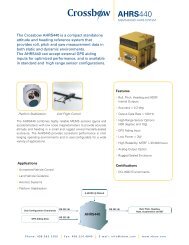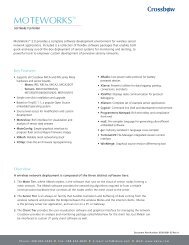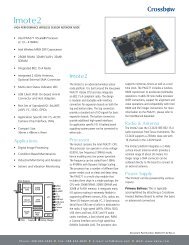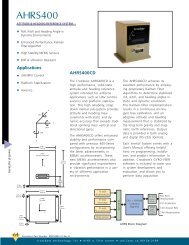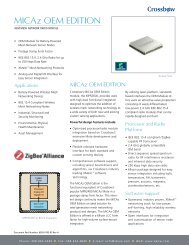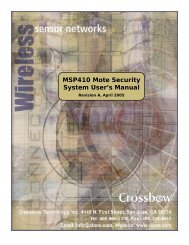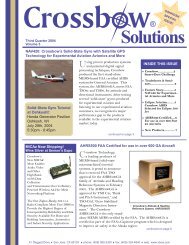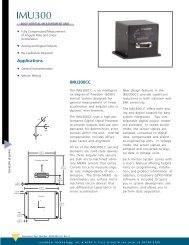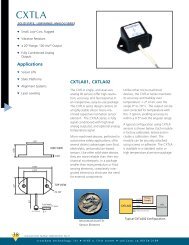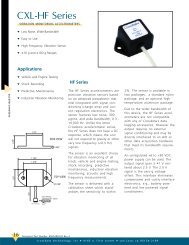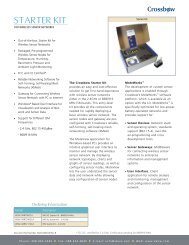MTS/MDA Sensor Board Users Manual
MTS/MDA Sensor Board Users Manual
MTS/MDA Sensor Board Users Manual
You also want an ePaper? Increase the reach of your titles
YUMPU automatically turns print PDFs into web optimized ePapers that Google loves.
<strong>MTS</strong>/<strong>MDA</strong> <strong>Sensor</strong> <strong>Board</strong> User’s <strong>Manual</strong><br />
5 <strong>MTS</strong>510CA<br />
The <strong>MTS</strong>510CA series sensor is a flexible sensor board with a variety of sensing modalities.<br />
These modalities can be exploited in developing sensor networks for a variety of applications<br />
including personnel detection, low-performance seismic sensing, movement, robotics, and other<br />
applications. The following section of the User’s <strong>Manual</strong> describes the sensor circuits and<br />
general application. Please refer to the schematic diagram at end of section for exact circuit<br />
details.<br />
5.1 Microphone<br />
The microphone circuit may be used for general acoustic recording and measurement. The basic<br />
circuit consists of a pre-amplifier (U4), second-stage amplified with a digital-pot control (U3,<br />
U1-A). In order to use the light sensor, digital control signal PW1 must be turned on.<br />
This circuit amplifies the low-level microphone output. This output can be fed directly into the<br />
analog-digital converter (ADC2). This configuration is useful for general acoustic recording and<br />
measurement. Audio files have been recorded into the Logger Flash memory of MICA, MICA2<br />
Motes for later download and entertainment (or analysis!).<br />
5.2 Light<br />
As on the <strong>MTS</strong>101CA, the <strong>MTS</strong>510CA has a light sensor. The light sensor is a simple CdSe<br />
photocell. The maximum sensitivity of the photocell is at the light wavelength of 690 nm.<br />
Typical on resistance, while exposed to light, is 2 kΩ. Typical off resistance, while in dark<br />
conditions, is 520 kΩ.<br />
In order to use the light sensor, digital control signal PW0 must be turned on. The output of the<br />
sensor is connected to the analog-digital converter channel 7 (ADC7). When there is light, the<br />
nominal circuit output is near VCC or full-scale, and when it is dark the nominal output is near<br />
GND or zero.<br />
5.3 2-Axis Accelerometer<br />
The accelerometer is a MEMS surface micro-machined 2-axis, ± 2 g device. It features very low<br />
current draw (< 1mA) and 10-bit resolution. The sensor can be used for tilt detection, movement,<br />
vibration, and/or seismic measurement. Power is controlled to the accelerometer by setting signal<br />
PW0, and the analog data is sampled on ADC3 and ADC4. The accelerometer, located at U2, is<br />
the ADXL202JE and the full datasheet is available at http://www.analog.com. A summary of<br />
specification is provided in Table 5-1 below for reference.<br />
Doc. # 7430-0020-05 Rev. A Page 19



